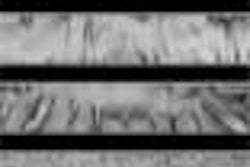Detecting hepatocellular carcinoma in the context of cirrhosis has always been challenging, as the latter disease causes liver lesions that mimic the former. Choosing the best method of detection has also been a challenge, given that the medical literature shows a vast range in accuracy for the relevant imaging exams.
Now radiologists and others primarily from the Innsbruck University Hospital in Austria have added to the literature with a prospective, blinded study evaluating the performance of both CT arterioportography and intraarterial digital subtraction angiography for evaluating patients for potential liver transplantation.
Their conclusion in the American Journal of Roentgenology probably isn’t surprising -- using both exams provides the most accurate information, particularly since DSA overcomes some specific weaknesses of CTAP. Nonetheless, the rigorousness of the group’s methodology would appear to bolster their findings (AJR, July 2003, Vol. 181:1, pp. 99-108).
"By combining hepatic digital subtraction angiography with CT arterioportography, we found that sensitivity improved slightly, whereas specificity and positive predictive value increased significantly," the authors wrote.
An accurate determination can be critical because a patient with cirrhosis faces a higher likelihood of developing hepatocellular carcinoma, yet the presence of cancer and its stage impacts the patient’s treatment and prognosis. A liver transplant would be precluded for patients with multiple carcinomas or a single carcinoma larger than 5 cm in diameter, they added.
Looking at the previous studies of several imaging approaches for detecting hepatocellular carcinoma in the cirrhotic liver, the Innsbruck group found mixed results. Seven studies of multiphasic CT found that its sensitivity ranged between 37% and 94%; another seven examining multiphasic MR imaging pegged its sensitivity at 55% to 93%. The largest gap came in studies of intraarterial angiography, which yielded sensitivities ranging from 33% to 95%. Somewhat more consistent were the findings for multidetector-row CT (sensitivity between 76% and 90%) and CT arterioportography (between 73% and 95%).
Those studies that used a more accurate pathologic analysis -- evaluating explanted livers rather than percutaneous biopsy or partial resection samples -- tended to provide the worst performance statistics for a range of modalities including single-slice CT and dynamic MR. In addition, the problem of false-positive results is widespread, reportedly occurring in up to 28% of CT findings, in up to 42% of sonographic findings, and up to 57% of MR cases.
CTAP has been recommended for pretransplantation workups by several earlier researchers, the authors noted, despite its false positive rate of up to 15%.
The latest study involved pretransplantation examinations of 59 patients with cirrhosis. The disease was due to hepatitis C in 28 cases, hepatitis B in five, alcoholism in 19, hemochromatosis in two, and undetermined causes in five cases. Because all patients subsequently underwent liver transplants, the prospective radiologic findings were precisely correlated to pathologic findings in the removed organs, which were examined in 5-mm sections cut to match the axial CT planes.
In addition to various noninvasive imaging studies used inconsistently, each patient underwent CTAP and intraarterial DSA in a single angiography suite session. CT was performed on a HiSpeed Advantage scanner (GE Medical Systems, Waukesha, WI) with scan delay determined by the GE Smart Prep technique.
The CT data were interpreted by two radiologists blinded to the DSA results and vice-versa. Then both sets of images were evaluated by two teams including an abdominal CT specialist and an angiographer.
In their results, CTAP alone achieved a sensitivity of 79.5% and specificity of 62.3; DSA alone delivered a sensitivity of 82.1% and specificity of 79.2%. Evaluations based on images from both modalities increased sensitivity to 87.2% and specificity to 81.1%.
"Because of the lack of a corresponding hypervascular lesion at digital subtraction angiography, the CT arterioportography and digital subtraction angiography combination improved the characterization of many low-attenuation nodules depicted on CT arterioportography (nine by team 1 and 12 by team 2) that were confirmed not to be hepatocellular carcinoma," the researchers noted.
In addition, the false positives that would result from small arterioportal shunts that look like hepatocellular carcinoma on CTAP can be overcome because of the shunts’ specific appearance on DSA.
But despite the improved accuracy achieved using both modalities, the researchers cautioned that a CTAP-DSA combination still has a relatively high false-positive rate.
"Recognizing the difficulty in the differentiation between early hepatocellular carcinoma and cirrhosis-relevant lesions, we believe that a percutaneous liver biopsy may be warranted in cases of suspected intrahepatic nodules," the authors concluded.
By Tracie L. ThompsonAuntMinnie.com contributing writer
July 29, 2003
Related Reading
Korean investigators share angiographic pitfalls of HCC, March 29, 2003
CT shows unique morphology of liver pseudolesions, May 5, 2001
Copyright © 2003 AuntMinnie.com




















